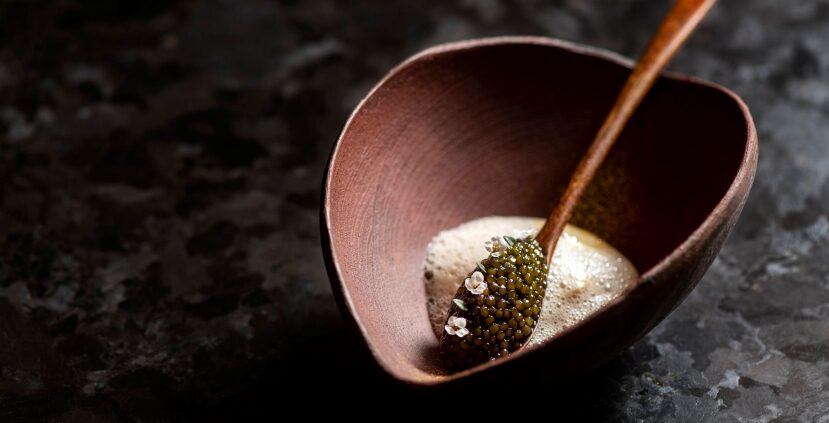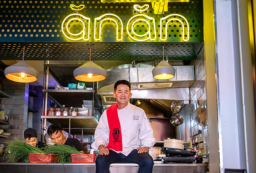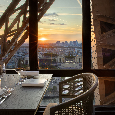
Classrooms can be rather stuffy and boring a lot of the time. The same material is regurgitated over and over again, and the teaching becomes slightly uninspiring. However, every so often, there comes along a very thought-provoking subject where the teacher seeks to engage students in a multi-faceted way of learning. At Atomix, this is what Junghyun and Ellia Park have succeeded in doing with delightful Korean cuisine. Welcome to a lesson in Korean cuisine at Atomix NYC.

In Manhattan’s NoMad neighbourhood, near to Koreatown, is Atomix. Run by chef Junghyun ‘JP’ Park and his wife, co-owner and manager Ellia Park, the restaurant serves a new innovative Korean cuisine with a ten-course tasting menu. Everything that can possibly thought of is meticulously planned down to the last detail. With the first floor serving a wonderful array of cocktails, it only serves to build excitement as guests descend to the lower level to eat. With only 16 seats available, all set around the U-shaped chef’s counter, exclusive and intimate doesn’t even begin to cover it.

JP Park was born in Gumi, South Korea, where he studied culinary science growing up. He swiftly left Korea to work in London and Melbourne respectively, honing his craft before returning to his homeland in order to begin his journey in Korean find dining. This would lead him to New York where he found great acclaim at the TriBeCa Restaurant and received two Michelin Stars. Only after this success, did he and his wife Ellia, set up Atoboy and then Atomix. The married couple credit their travelling experiences as to their inspiration regarding their vision of Atomix. Ato in Japanese means gift and there is a firm belief that life’s experiences are a gift. The Korean gastronomy is expressed within the context of contemporary culture. The emphasis is on the journey not the destination, there is no perfect answer to Korean food, rather a constant ever-evolving meditation of Korean cuisine.

"The Korean gastronomy is expressed within the context of contemporary culture."
The ten-course menu is the staple of Atomix, consisting of eight savoury dishes and two desert courses, plus a variety of seasonal rice and banchan carefully paired with some of the dishes. Before each course comes a card with a transliteration of a Korean word under some eyecatching shapes and designs. The idea is to embed guests into Korean cuisine culture, with the other side of the card featuring all the ingredients needed to make the dish, often surpassing more than 20. Through this journey through the delightful courses, diners get a sense firsthand of the sophistication and intricacy of all the dishes they are about to try.
The first dish is introduced as ‘guk’, meaning soup. This golden broth is held in a beautiful bowl with great overtones of pork. Another card is handed to each guests titled ‘hoe’, which essentially means raw. This dish is a raw fish platter involving seabream, that has been marinated in a tangerine sauce and aged for one day before serving.

Fermentation is the cornerstone of all Korean cuisine, and this is most certainly shown throughout the ten-course menu. For the luscious waygu strip loin, fermentation infuses a mixture of Korean pears, pineapple and green apples to create a sensational cidery marinade. Fermentation is also at the heart of Atomix’s use of vegetables, the most notable being the tart brussel sprouts served alongside roast duck and gochujang.
To top it all off, Korean restaurants aren’t traditionally known for their deserts, but Atomix is going a long way to change that perception. In particular, the rice pudding which is topped with a quenelle of rice ice cream made from thyme honey and pickled sprout juice. Delectable and delicious, it is the perfect way to round off the most flavoursome of tasting menus.

To make the most out of ten courses, the choice of chopstick is crucial. With 40 options available, all crafted by different Korean artists and taken from JP and Ellia’s personal set, it is a sacred ritual.
Some plates are carefully hand-crafted jade-hued ceramic bowl by JP’s cousin, Youme Oh. This is done to mimic traditional Korean wares. Other plates were commissioned to different South Korean makers, including established porcelain master Namhee Kim.

"With 40 options available, all crafted by different Korean artists and taken from JP and Ellia’s personal set, it is a sacred ritual. "
In many ways the location is rather secretive and almost neutral as guests are often surprised with the unassuming exterior of the house located on East 30th Street. The Park’s hired Seoul architecture firm Studio Writers and Younglae Kim to design the clever interiors of Atomix. The first floor bar and lounge features muted wood and black accents. Guests can enjoy a sumptuous variety of cocktails and light bites including soy-marinated scallop jerky.
When the time has come, guests are ushered downstairs to a zen-like room, full of natural materials and simple designs which seem to ooze a sense of calm and tranquillity. Servers and chefs alike are all adorned in boat-neck shirts, the work of Korean designer Sungho Ahn. A warm and homely oasis away from the hustle and bustle of Manhattan provides guests with the rare opportunity to sit back, relax and let the flavours go to work.

Tasting menus, especially when ten courses, have the tendency to become rather spiritless and uninteresting as the chef increasingly runs out of ideas, but not at Atomix. Each dish is wonderfully unique, possessing different textures and flavours to ensure that guests will experience something different every time. It is also more than just the food, but a history lesson in Korean culinary culture. An immersive experience gastronomically as well as intellectually. A third Michelin star is most certainly not out of the question and hovering on the horizon.
















